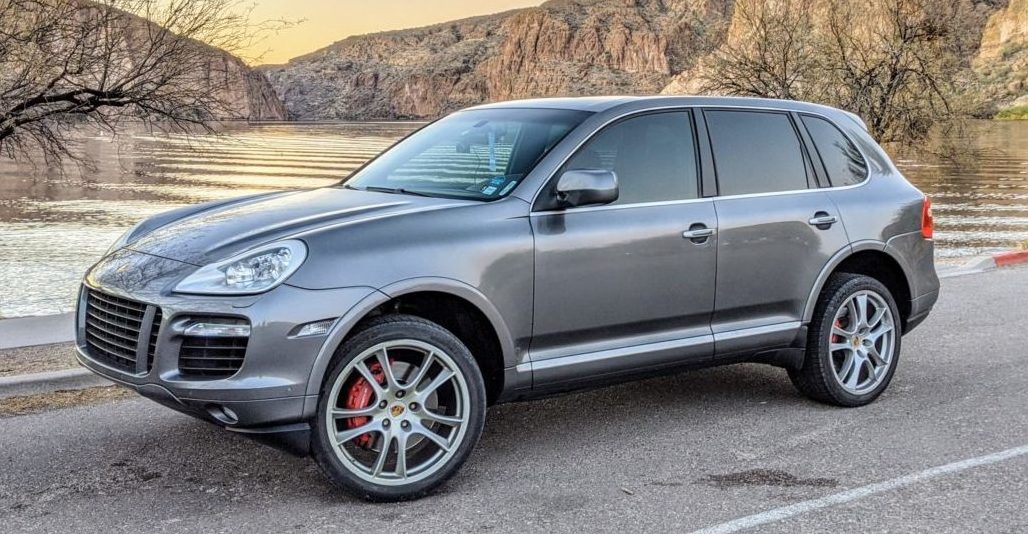
Quick Answer on buying a Used Porsche Cayenne
Should you buy a used Porsche Cayenne? Unless you’re a car enthusiast or have deep pockets, probably not. The Porsche Cayenne is arguably the best SUV that can do it all, but be prepared for expensive maintenance and repair bills. If you decide to buy a used one, we recommend you buy an extended car warranty and find a good independent Porsche mechanic.
Introduction
The Porsche Cayenne is the 911 of SUVs. Brand new, top of the range Cayenne models cost over $100,000 and have over 500 horsepower. Today, you can pick up a used Porsche Cayenne for less than 20% of its original MSRP, but should you? In this article, we’ll walk you through the ownership considerations for each Porsche Cayenne generation.
Let’s start with a simple test. If you answer yes to the following questions, then the Porsche Cayenne could be right for you.
- You want a great looking SUV with a premium feel.
- Whether its hauling groceries around, carving canyons, or taking a serious trip off-road, you want an SUV that can do it all.
- Fuel economy? If you cared, you would buy a Toyota Prius.
- You’ve never towed anything in your life, but knowing that you “could” is cool 😎.
- Occasionally spending $3,000 on repairs is not a big deal for you.
Now let’s cover the different Porsche Cayenne generations.
Porsche Cayenne 955 (2003-2006)
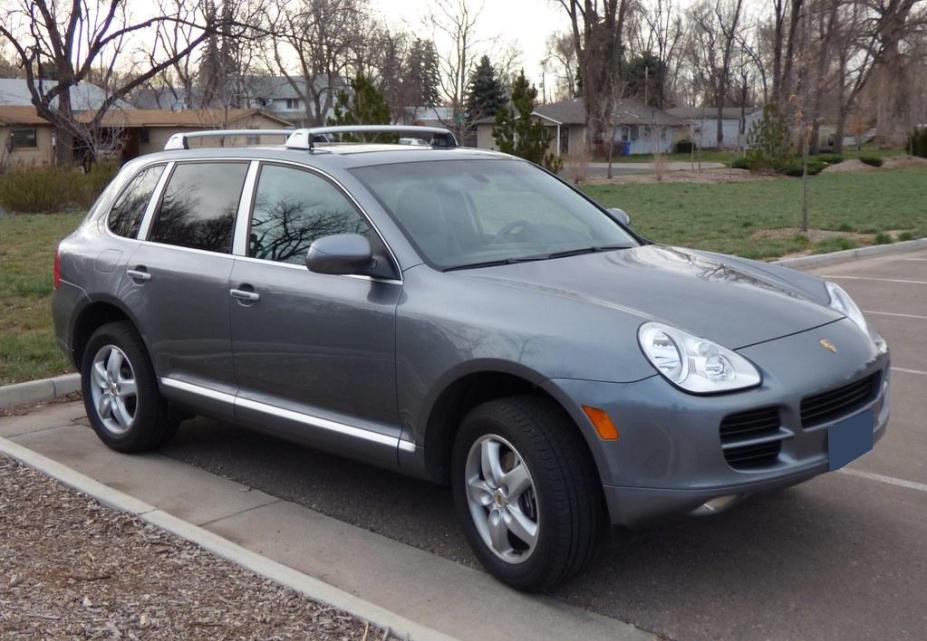
Porsche 955 Cayenne S (“Yvcyn_1b” by gvgoebel is licensed under CC BY-SA 2.0)
History
In 2003, Porsche began selling the very first Cayenne in the United States. The Cayenne marked uncharted territory for a sports car manufacturer. While Lamborghini released the LM002 in the 1980s, no sports car manufacturer had successfully developed a mass-market, premium SUV. With Porsche sales starting to recover in the late 1990s after the release of the Porsche 986 Boxster and 996 911, Porsche made a bold bet that it could extend its brand to the growing SUV market. To make the project financially viable, Porsche and Volkswagen co-developed the PL71 platform, which was used for the Porsche Cayenne, Volkswagen Touareg, and Audi Q7.
Now you might be thinking that the Porsche Cayenne is simply a rebadge Volkswagen Touareg. However, Porsche developed its own V8 drivetrains, suspension tuning, and exterior and interior designs. In 2003, the Porsche Cayenne made up 45% of Porsche’s U.S. vehicle sales. As a result, Porsche would eventually become the world’s most profitable automaker.
Porsche Cayenne 955 Trims
The 955 Cayenne was offered in 4 trims: Base, S, Turbo, and Turbo S. All trims came standard with all-wheel drive and a 6-speed Tiptronic transmission with a two-speed transfer case and locking center differential. Also, all 955s are rated to tow up to 7,716 lbs. As a result, the 955 Cayenne is a rugged SUV that is extremely capable off-road. So if any Jeep owners give you crap on the trail, just ask, “Dear sir, can your Jeep tow seven thousand, seven hundred and sixteen pounds?”.
Porsche Cayenne Base (V6)
The base 955 features a 3.2 liter V6 with 247 horsepower and 228 ft-lbs of torque. Due to its weight of nearly 4,800 pounds, the base 955 requires 9 seconds to do 0 to 60 mph and 16.5 seconds to complete the standing quarter-mile. You might think the V6 gives the base 955 decent fuel economy, but it only achieves 14 MPG (city) and 18 mpg (highway). On the upside, the base 955 is the only trim that you could get with a manual transmission, but good luck finding one 😊.
Porsche Cayenne S
The Cayenne S features a 4.5 liter V8 with 340 horsepower and 310 ft-lbs of torque. It also received larger 350mm brakes up front. If you want an SUV that won’t be a slouch to drive around town, the S checks the box. It can do 0-60 mph in 6.5 seconds and the 1/4 mile in 15 seconds. Despite the V8 engine, the S only takes a small hit in fuel economy over the base. It’s EPA rating is 12 MPG (city) and 17 MPG (highway). In 2006, Porsche offered a special version called the “S Titanium”. This package included many standard options such as 19 inch wheels, special exhaust tips, aero rocker panels, and two-tone leather.
Porsche Cayenne Turbo
At the time of its release, the Cayenne Turbo was the fastest production SUV in the world. It uses a twin-turbo, 4.5 liter V8 that puts out 450 horsepower and 460 ft-lbs of torque. As a result, the Cayenne Turbo can do 0 to 60 mph in 5.5 seconds and complete the quarter-mile in around 14.0 seconds. Despite the big power increase, the Cayenne Turbo is still rated at 12 MPG (city) and 17 MPG (highway). In addition, the Cayenne Turbo came with air suspension, a full leather interior, and revised front and rear fascias.
Porsche Cayenne Turbo S
The king of the 955 range is the Turbo S, which features a modified version of the Turbo’s engine. This increased horsepower to 520 and torque to 530 ft-lbs. The Turbo S also received the biggest brakes in the range featuring enormous 380 mm brake rotors up front and 358 mm brake rotors in the rear. The additional power allows the 955 Turbo S to shave half a second off its 0-60 mph and 1/4 mile times.
Reliability
If you’ve read this far and are convinced you want a 955 Cayenne, please be warned that you should read this section before making up your mind. Porsche Cayenne was wildly successful for Porsche’s first attempt, but it wasn’t without its faults. Let’s take a look at all the common issues.
| Drive shaft support bearing (All 955s affected | $1,000 to fix)
The drive shaft is supported by a bearing that is known to fail around 40,000 to 60,000 miles. This issue happens on virtually every Cayenne and should be proactively addressed. If you don’t catch the issue early, add another $1,500 to the bill to replace the drive shaft. |
| V8 coolant pipes (All V8 models affected | $1,500)
V8 models featured, get this, plastic coolant pipes! Insane right? These coolant pipes eventually crack on virtually all V8 engines. If this issue isn’t addressed quickly, the coolant can leak down onto the transmission and ruin the transmission’s valve body, which will cost you an additional $1,500 to fix. Fortunately, the V6 models do not have this issue. |
| Water intrusion into the cabin (All 955s affected | Repair $ Depends on Severity)
Water can get into the cabin if you do not periodically clean out the various body drains that allow water to drain out of the vehicle. A certified Porsche mechanic can clean all the drains out as part of routine maintenance in less than an hour, so this problem is easily preventable. However, neglecting maintenance can set you back thousands of dollars depending on the severity of the water damage. |
| Transmission Valve Body (Early year 955s | $2,000 to fix)
Early year Cayennes could develop rough shifting due to how Porsche programmed the transmission control unit (TCU). Porsche later updated the TCU. However, if the issue wasn’t caught early, it would lead to a worn out transmission valve body. |
| Ignition coils (All 955s affected | $500 to $1,000 to fix)
You should consider the ignition coils as wear-and-tear items on the Porsche Cayenne. At round 60,000 to 80,000 miles, the ignition coils typically crack and fail, which can leave you stranded on the side of the road. You should expect to replace the ignition coils during every other spark plug change. |
| Water pump and thermostat (V8 955s affected | $1,500)
The coolant issues continue on V8 models. The water pump and thermostat are known to go out before 100,000 miles. |
| Air suspension compressor (955s with air suspension | $100 to fix) The 955’s air suspension is very reliable. However, some owners have reported air suspension compressor failures. Fortunately, the compressor just needs new seals. A mechanic can fix this for a few hundred dollars or you can fix it yourself for less than $100 with this repair kit. |
| V8 Bore Scoring (Rare problem on V8 models | $10,000+ to replace motor)
A small fraction of V8 Cayenne owners have reported bore scoring. Bore scoring occurs when the pistons contact the cylinder walls and score both surfaces. This issue is more likely to occur in cold climates where engines can struggle to get proper lubrication during startup. If you hear an audible thumping noise coming from the engine, beware. |
| Miscellaneous Issues (All 955s | Varies)
With 955s all being greater than 15 years old, you will run into a bunch of issues that older cars all face. These issues include the vacuum pump, alternator, wheel bearings, worn control arms, worn engine mounts, etc. These issues will cost you more to fix on a Cayenne than on your typical car. To avoid these issues, find a 955 with an extensive maintenance record or budget several thousands of dollars into the purchase price to get your used 955 back in tip top shape. |
Value – FAIR
The 955 represents a fair value overall. While it’s cheap to purchase, it’s expensive to maintain and operate. Expect to budget around $7,500 per year for maintenance, operating costs, insurance, and registration. Let’s take a closer look at the expenses you can expect.
Purchase Price & Depreciation
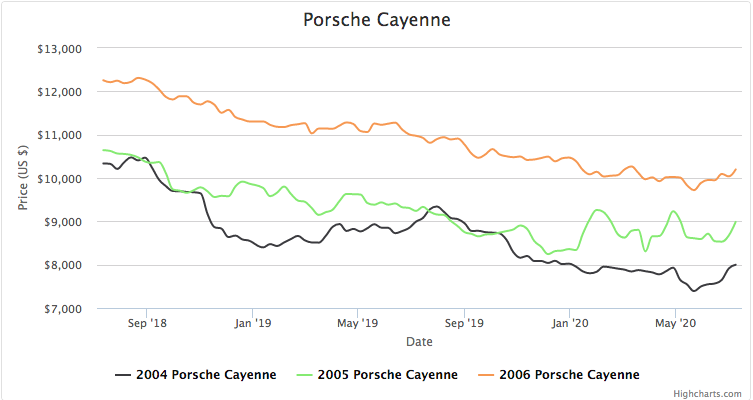
Porsche Cayenne 955 Used Prices from www.cargurus.com
According to CarGurus data, the average 955 price ranges from $8,000 to just over $10,000. While the 955 has depreciated by ~20% in the last two years, most have already lost 85% of their original values. The 955 still has room to depreciate further, but you won’t lose more than a few thousand dollars over several years of ownership. The data isn’t broken out by trim, but expect to pay the following prices for a 955 in good shape:
| Trim | Low End | High End |
| Cayenne (V6) | $6,000 | $8,000 |
| Cayenne S | $7,000 | $10,000 |
| Cayenne Turbo | $9,000 | $10,000 |
| Cayenne Turbo S | $14,000 | $18,000 |
However, don’t fixate too much on prices. A 955’s mileage, condition, and service history will drastically impact how much it is worth. Given one or two “minor” repairs on a Cayenne can set you back a few thousand dollars, we recommend buying a 955 with verifiable service records even if it means paying a little bit more.
Maintenance
Maintenance is the next big expense item when it comes to owning a 955. Parts and labor are expensive and, given 955s are all nearly 15 years or older, a 955 will require frequent repairs. Expect to pay your independent mechanic $250 for an oil change. If you have a mild issue, such as a failed ignition coil, expect to pay at least $1,000. Despite the ability to purchase a 955 for less than $10,000, you’re still maintaining a car with an original purchase price of over $60,000 (in today’s money).
Operating Costs
Operating a 955 isn’t cheap due to the cost of consumables. Let’s break down the main operating expenses:
| Expense | Price | Cost Per Mile |
| Premium gas | $3 per gallon (14 MPG) | $0.21 |
| Tires | $1,200 (30k miles per set) | $0.04 |
| Brakes | $1,800 (40k miles per set) | $0.045 |
| Total | $0.30 | |
| Annual operating costs (@ 12,000 miles per year) | $3,600 | |
For the main consumables alone, you can expect to pay around $3,600 per year. You’ll also need to factor in car insurance and registration. However, these costs should be pretty reasonable given the 955’s age.
Porsche Cayenne 957 (2008-2010)
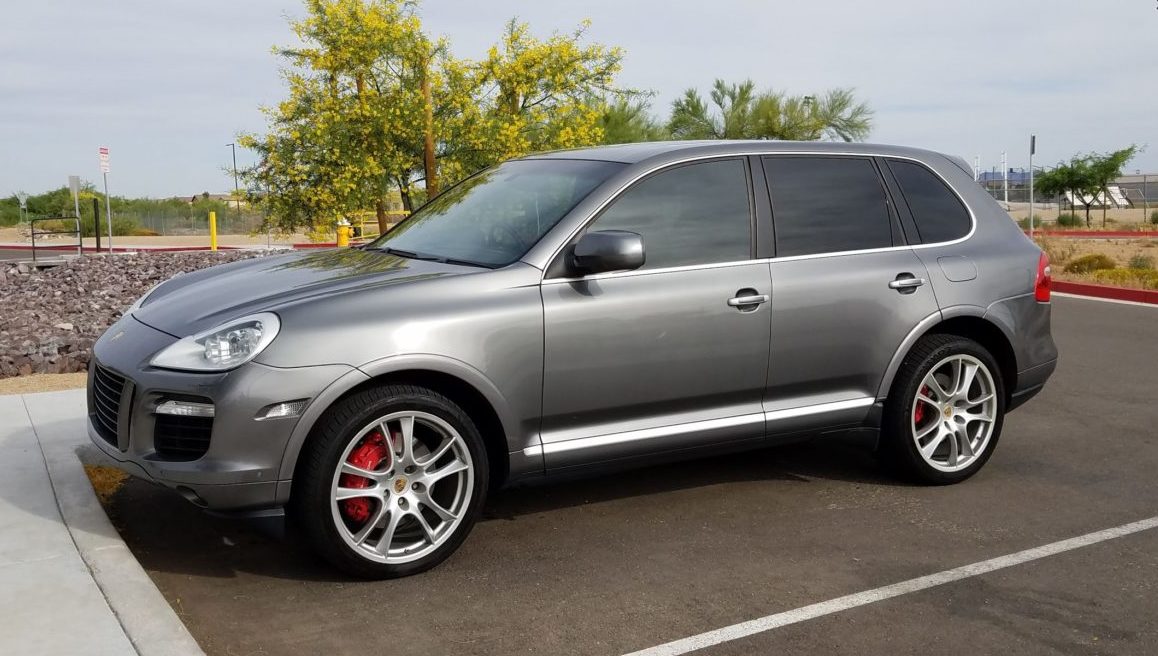
2008 Porsche Cayenne Turbo
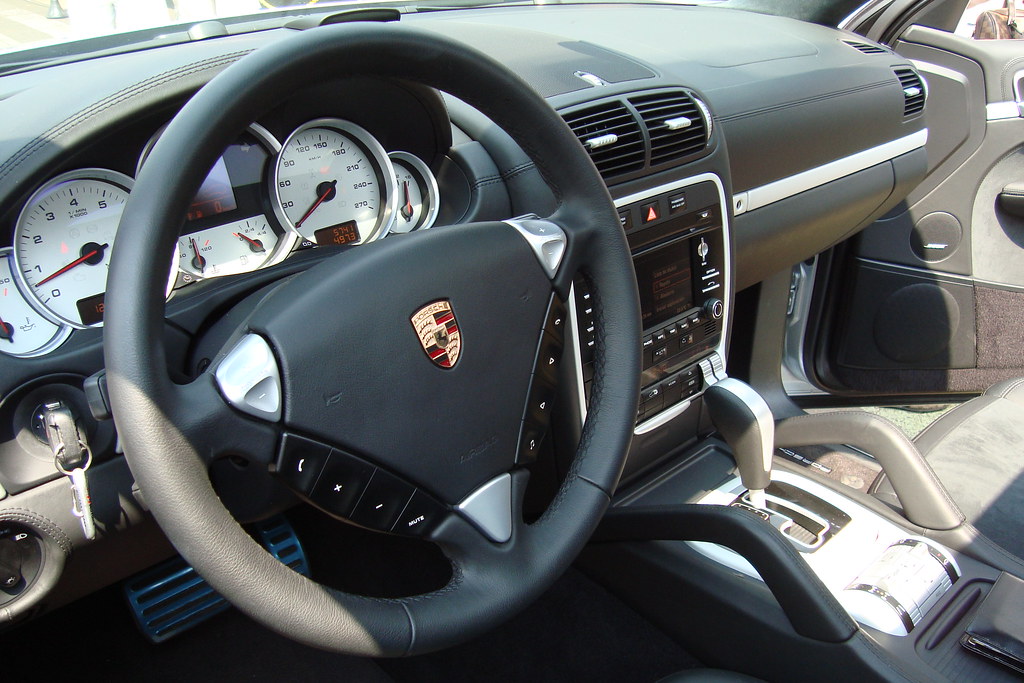
“EXPERIMENT MOTORS GOIANIA 2010 – SEGUNDA EDIÇÃO” by João Paulo Fotografias is licensed under CC BY-ND 2.0
History
In 2008, Porsche released the 957, which was actually just a mid-cycle refresh of the 955. Across the entire lineup, the 957 received new direct fuel injection (DFI) engines. The 957 also received revised front and rear fascias with more angular headlights and LED tail lights.
Porsche Cayenne 957 Trims
Porsche Cayenne (V6)
The Cayenne Base received an updated 3.6 liter V6 engine that pushed power and torque up to 290 horsepower and 273 ft-lbs. Despite the power increase, the new DFI engine also improved fuel economy to 14 MPG (city) and 20 MPG (highway). While rare to find, Porsche did continue to offer the base model with a 6-speed manual transmission.
Porsche Cayenne S
The S received a new 4.8 liter, DFI V8 with 385 horsepower and 369 ft-lbs of torque. Fuel efficiency increased slightly to 13 MPG (city) and 19 MPG (highway). The extra power allowed the 957 S to sprint 0 to 60 mph in 6 seconds and complete the standing quarter-mile in 14.5 seconds.
Porsche Cayenne GTS
The GTS is very similar to the Cayenne S, but features numerous upgrades. The GTS features the same 4.8 liter engine from the S, but Porsche tuned the engine to make 405 horsepower. Additionally, the GTS came with the following options as standard: sport design exterior package, 21 inch wheels, sport seats with Alcantara inserts, air suspension, and Porsche Sport Exhaust (PSE).
The GTS also could be equipped with a 6-speed manual transmission and Porsche Dynamic Chassis Control (PDCC). PDCC provides hydraulically controlled sway bars that can keep the Cayenne virtually flat while cornering. It also simulates disconnected sway bars to provide more suspension articulation in off-road scenarios. PDCC is a great option, but does present one more complex system that you’ll need to maintain.
Porsche Cayenne Turbo
The 957 Turbo received a twin-turbo 4.8 liter, DFI V8 which increased output to 500 horsepower and 516 ft-lbs of torque. With the extra power, the 957 Turbo can do 0-60 mph in 4.8 seconds and complete the 1/4 mile in 13.5 seconds. Fuel efficiency improved slightly to 12 MPG (city) and 19 MPG (highway). The Turbo also received larger brakes, a full leather interior, and air suspension as standard.
Porsche Cayenne Turbo S
The Turbo S uses a tuned version of the Turbo’s engine and puts out 550 horsepower and 553 ft-lbs of torque. As a result, the 957 Turbo S can do 0 to 60 mph in 4.5 seconds and the quarter-mile in 13.0 seconds. In addition, the Turbo S came with the following options as standard over the Turbo: PDCC, PSE, 21 inch wheels, sport design appearance package, and larger 380mm brake rotors up front.
Reliability
The 957 is slightly more reliable than the 955, but still has some of the old issues along with new ones. Let’s take a look at the issues you can expect.
| Issue |
| Drive shaft support bearing (All 957s affected | $1,000 to $2,500 to fix)
Still an issue on the 957 |
| V8 coolant pipe fitting (All V8s affected, but issue unlikely before 100k miles | $2,500 to fix)
The 957 V8 engines no longer use plastic coolant pipes. However, one of the coolant pipe fittings is glued to the thermostat housing. Over time, the glue can fail which will lead to a coolant leak. To fix the issue, a mechanic can simply pin the coolant pipe fitting in place. Unfortunately, your mechanic will need to remove the entire engine. |
| Water intrusion into the cabin (All 957s affected | Repair $ depends on severity)
Still an issue on the 957 |
| Ignition coils (All 957s affected | $500 to $1,000 to fix)
Still an issue on the 957 |
| Water pump and thermostat (All 957s affected | $1,500)
Still an issue on the 957 |
| Air suspension compressor (957s with air suspension affected | $100 to fix yourself)
Still an issue on the 957 |
| V8 Bore Scoring (Rare problem on V8 models | $10,000+ to replace motor)
Unlikely, but still a possibility |
| Miscellaneous Issues (All 957s affected | Repair $ varies)
Still an issue on the 957 |
Value – FAIR
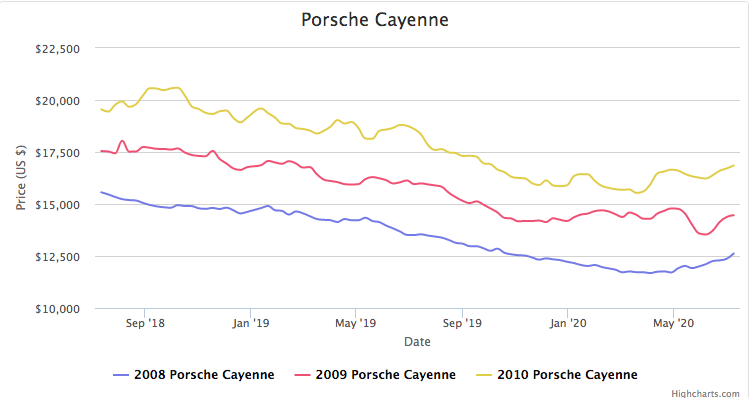
The 957 represents as good of a value as the 955. While 957s are more expensive than 955s, they have depreciated a little less than the 955 in the last 2 years (~17% v.s ~20% respectively) because of the 957’s slightly better reliability. However, we still recommend budgeting around $7,500 per year for maintenance, operating costs, insurance, and registration.
Porsche Cayenne 958 (2011-2018)
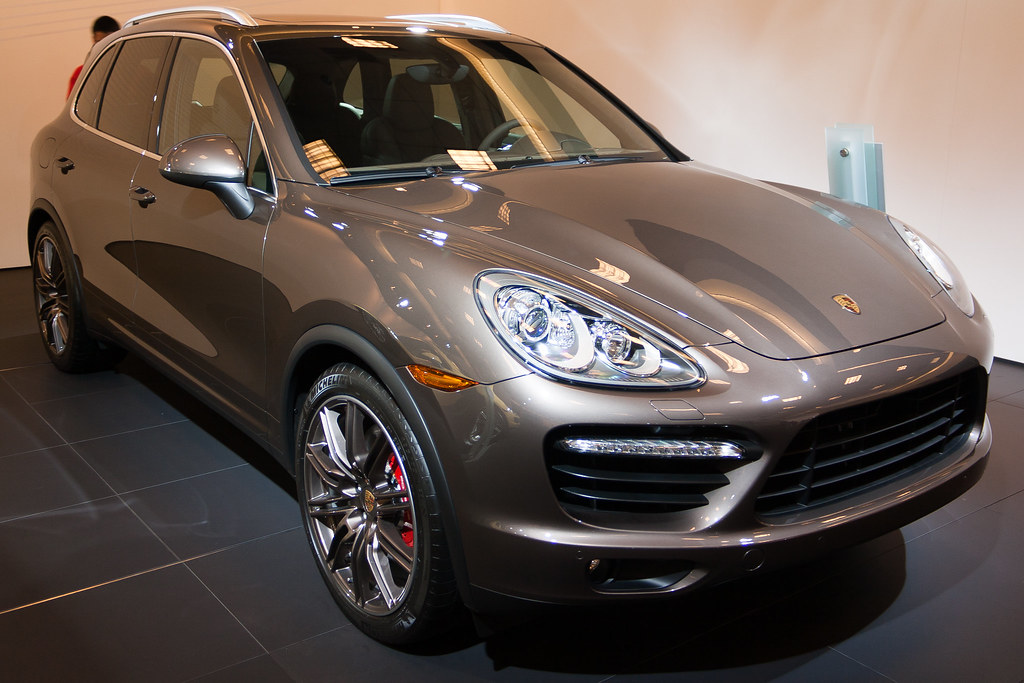
958.1 Porsche Cayenne Turbo (“Porsche Cayenne Turbo” by CFlo Photography is licensed under CC BY-SA 2.0)
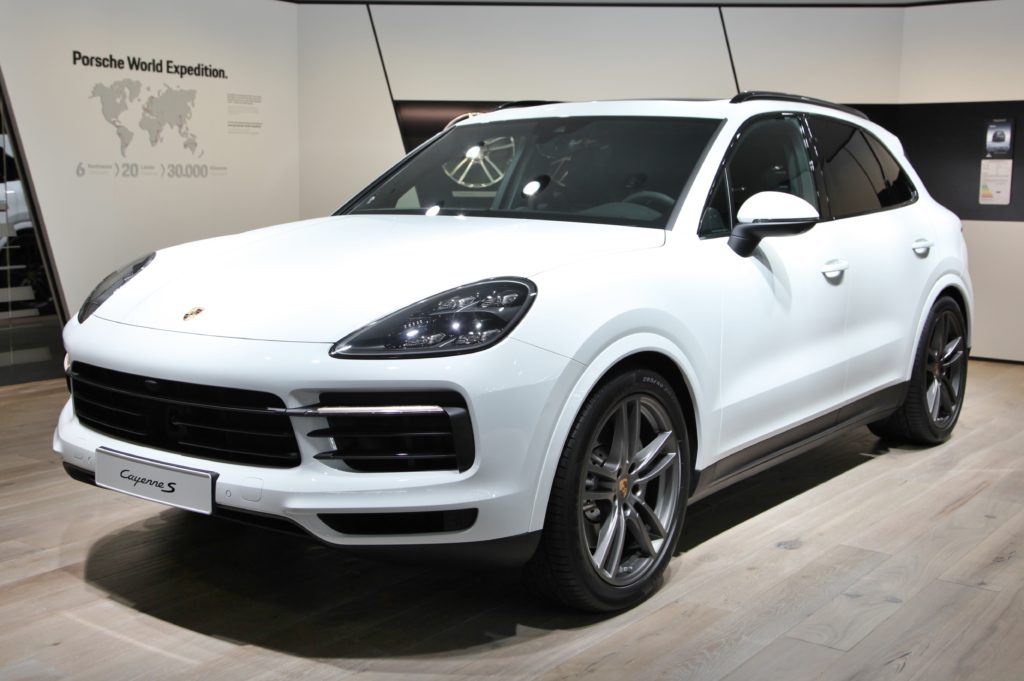
958.2 Porsche Cayenne S (“File:Porsche Cayenne S IMG 0627.jpg” by Alexander Migl is licensed under CC BY-SA 4.0)
History
In 2011, Porsche released the completely redesigned, second-generation Cayenne. Porsche carried over the 957 engines into the first generation of the 958, but upgraded the transmission to an 8-speed Tiptronic unit. From the exterior, the 958 received a more sleek and urban look. Porsche also was able to cut the Cayenne’s weight by nearly 400 pounds thanks to the use of a single-speed transfer case and lighter materials. The 958’s towing capacity remained unchanged at 7,716 pounds.
The 958 interior received a full redesign. The cabin design made the 958 feel much more modern and upscale. The 958 also marked the shift to Porsche’s “Panamera” interior style which features the center console that angles up towards the dashboard. Porsche never has been on the cutting edge of infotainment, but the 958 did give owners the ability to stream music via Bluetooth.
In 2015, Porsche released a mid-cycle refresh that featured revised front and rear fascias and new turbocharged V6 engines for the S and GTS models. In the next section, we’ll explore the main differences between various Cayenne versions.
Note: 958.1 refers to 2011 to 2014 model years. 958.2 refers to 2015 to 2018 model years.
Trims
Porsche Cayenne (V6)
During the entire 958 lifecycle, the base models featured a revised version of the 3.6 liter, DFI V6 engine from the 957. Power was bumped up to 295 horsepower and torque increased to 295 ft-lbs. In 2016, the base model received a 5 horsepower increase. Due to the lighter weight of the 958, MPG increased to a more respectable 19 MPG (city) and 24 MPG (highway). 0-60 mph also improved to around 7.5 seconds.
Porsche Cayenne Diesel
In 2013, Porsche introduced the first diesel version of the Cayenne in the United States. The Cayenne Diesel has a turbocharged 3.0 liter, V6 diesel engine which put out 240 horsepower and 406 ft-lbs of torque. The Diesel achieves a respectable 20 MPG (city) and 28 MPG (highway).
Porsche Cayenne S
From 2011 to 2014, the Cayenne S used the same V8 engine from the 957, but power increased to 400 horsepower. As a result of the 958’s lighter weight and slight bump in power, it can do 0-60 mph in ~5.5 seconds and the quarter mile in 14 seconds. Fuel economy also improved to 16 MPG (city) and 22 MPG (highway).
In 2015, Porsche gave the Cayenne S a new turbocharged, 3.0 liter V6 engines that put out 420 horsepower and 406 ft-lbs of torque. Thanks to the big bump in torque, the 958.2 Cayenne S can do 0 to 60 mph in 5 seconds and the quarter mile in 13.5 seconds. Fuel economy further improved to 17 MPG (city) and 24 MPG (highway).
Porsche Cayenne S Hybrid & S E-Hybrid
From 2011 to 2014, Porsche offered the Cayenne S Hybrid model which used a supercharged 3.0 liter V6 paired with an electric motor. It put out 380 horsepower and 428 ft-lbs of torque and could achieve 20 MPG (city) and 24 MPG (highway).
In 2015, Porsche released the Cayenne S E-Hybrid, which was Porsche’s first plug-in model. The S E-Hybrid has an all-electric range of up to 22 miles and a 47 MPG-equivalent fuel economy rating. Additionally, Porsche bumped power to 416 horsepower and torque to 435 ft-lbs. This allows the S E-Hybrid to do 0-60 mph in around 5.5 seconds and the quarter mile in the high 13 second range. Not bad for a family hauling hybrid!
Porsche Cayenne GTS
The 958.1 and 958.2 GTS use the same engines as their S equivalents. However, they received slight power bumps. Power and torque on the 958.1 increased to 420 hp and 380 ft-lbs. The 958.2 GTS received 440 horsepower and 443 ft-lbs of torque. Like the prior 957 GTS, the 958 GTS came with many options as standard over the S such as sport design exterior package, larger wheels, sport seats with Alcantara, PSE, and air suspension.
Porsche Cayenne Turbo & Turbo S
The 958 Turbo and Turbo S models utilize updated versions of the twin-turbo, 4.8 liter V8 engines from the 957. The 958.1 Turbo (2011-2014) came with 500 horsepower and 516 ft-lbs of torque. In 2015, Porsche bumped the Turbo’s power and torque to 520 horsepower and 553 ft-lbs.
The 958.1 Turbo S (2013-2014) received 550 horsepower and 516 ft-lbs of torque. Later, the 958.2 Turbo S (2015-2018) received 570 horsepower and 590 ft-lbs of torque. As a result, the range topping 958.2 Turbo S can do 0-60 mph in 4 seconds flat and complete the quarter mile in just 12.5 seconds.
Reliability
The 958 gave Porsche a chance to learn and address issues from the prior generation. While Porsche improved the 958’s overall reliability, the 958 still has its fair share of issues.
| Issue |
| V8 Variocam Bolts Recall (Very likely on 2011 and early 2012 V8 models | Should be covered by recall)
2011 and early 2012 V8 Cayennes used aluminum bolts to secure the camshaft adjusters together. These bolts has been known to fail, which can cause serious engine damage. When purchasing a used 958, be sure this issue has been addressed. |
| Transfer Case (All 958s affected | $4,500 to fix)
With exception to diesel and hybrid models, some 958s owners experienced transfer case failures. As the transfer case begins to fail, you may experience the transmission slipping or accelerating/decelerating in a jerky manner. The exact cause of the problem is unknown. The current fix for the issue is a complete transfer case replacement. |
| V8 coolant pipe fitting (Early year V8s affected | $2,500 to fix)
The earlier model year V8 models are susceptible to the same coolant pipe fitting issue from the 957 V8 models. Later years used a revised thermostat housing that resolved the issue. This issue is not likely to affect a vehicle until after 100,000 miles. |
| Water intrusion into the cabin (All 958s affected | Repair $ varies)
Still an issue on the 958 |
| Ignition coils (All 958s affected | $500 to $1,000 to fix)
Still an issue on the 958 |
| V8 Bore Scoring (Rare issue on V8 models | $10,000+ to replace motor)
Unlikely on the 958, but still possible. Beware of vehicles from cold climates. |
Value – Poor
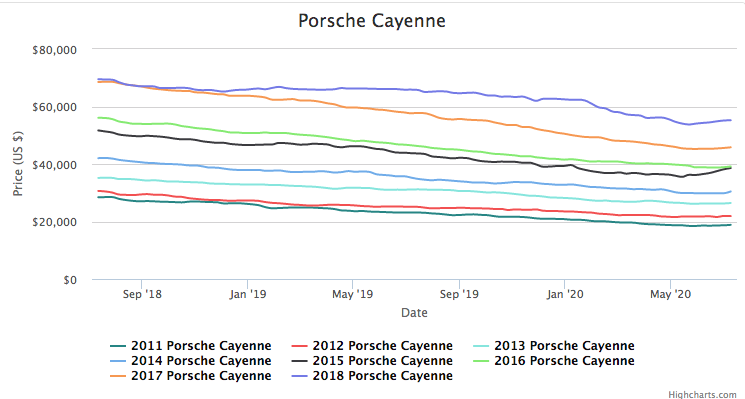
The 958 Cayenne represents a poor value. At face value, you can buy an amazing SUV that can do-it-all from anywhere around $20,000 for an early year base model to $60,000 for a relatively new Turbo S. However, just like on the 955 and 957, expect to lose money on depreciation. According to CarGurus data, in the past 2 years, 958 Cayennes have depreciated by ~30% across the board. In addition, the 958 Cayenne will be just as expensive to maintain and operate. If you do decide to buy a 958, factor $6,000 to $9,000 per year for gas, maintenance, repairs, insurance, and registration.
Our Recommendation on Buying a Used Porsche Cayenne
A properly maintained Porsche Cayenne is an amazing SUV that can do it all. However, if you’re looking for a low maintenance SUV, the Porsche Cayenne is NOT RIGHT for you. On the other hand, if you have the interest and ability to do some of your own maintenance and repairs, a used Porsche Cayenne is actually a great value for what you get. If you do decide to buy a used Porsche Cayenne, we recommend you budget around $7,500 per year to cover maintenance and operating costs. We also recommend that you purchase an extended car warranty and find a good independent Porsche mechanic.
To see how you can save money on maintenance, check out our detailed maintenance guides. While we encourage Porsche owners to do-it-yourself to save money and get the full Porsche ownership experience, we understand DIY is not for everyone. Check out our service center recommendations to find a highly rated, Porsche mechanic near you. Thanks for reading and subscribe to eCarGuides to get the latest information for all of your car ownership needs.

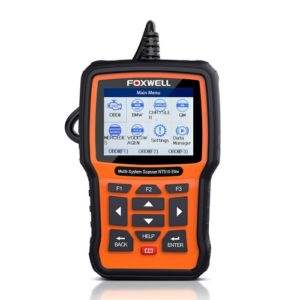
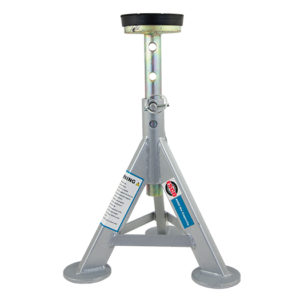
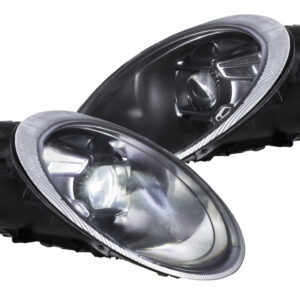

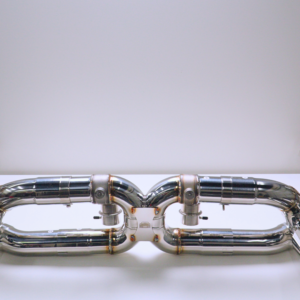

Olu says:
Thanks very useful.
Rui says:
Hello
Great info but can you please guide me here
Where I live tariffs are really high which means a brand new cayenne could cost up to 20000$ if not more on a turbo.
A week ago I came across a 2012 turbo with only 17’000 miles on it that cost around 83’000$ do think it could be worth it and it could sustains atleast another 5 years … one more question Does it have the twin clutch or an auto ? And was the pdcc standard by then … thanks a lot
Rui says:
Plus it’s out of warranty I am sure you figured
Bill says:
Great article; thank you. I want to purchase a 2015 diesel with under 60000 miles that has an extensive service history. I have many diesel trucks and storage tanks so fuel will be available at just above wholesale.
Are there any major issues I should look for and will it be the highway cruiser I exoect?
Thanks
Bill says:
I want to purchase a 2015 diesel with under 60000 miles that has an extensive service history. I have many diesel trucks and storage tanks so fuel will be available at just above wholesale.
Are there any major issues I should look for and will it be the highway cruiser I exoect?
Thanks